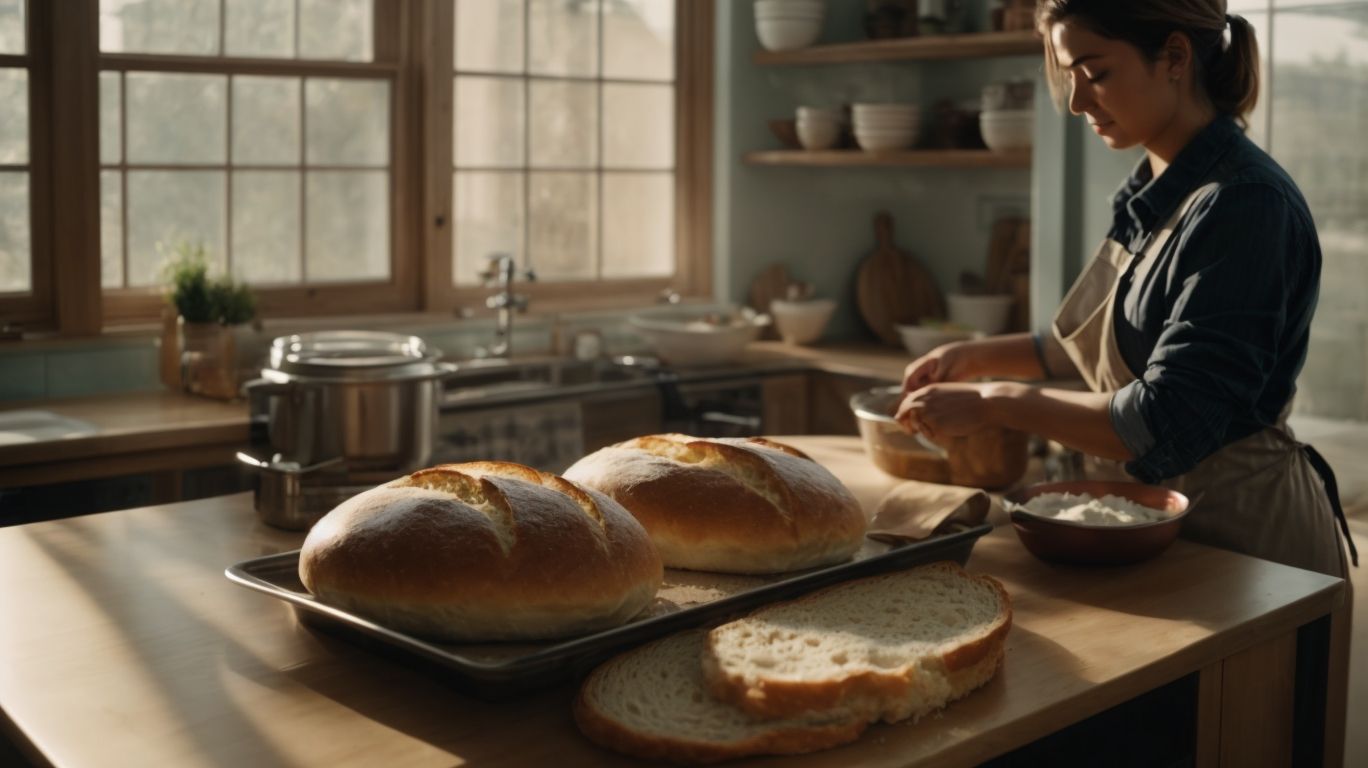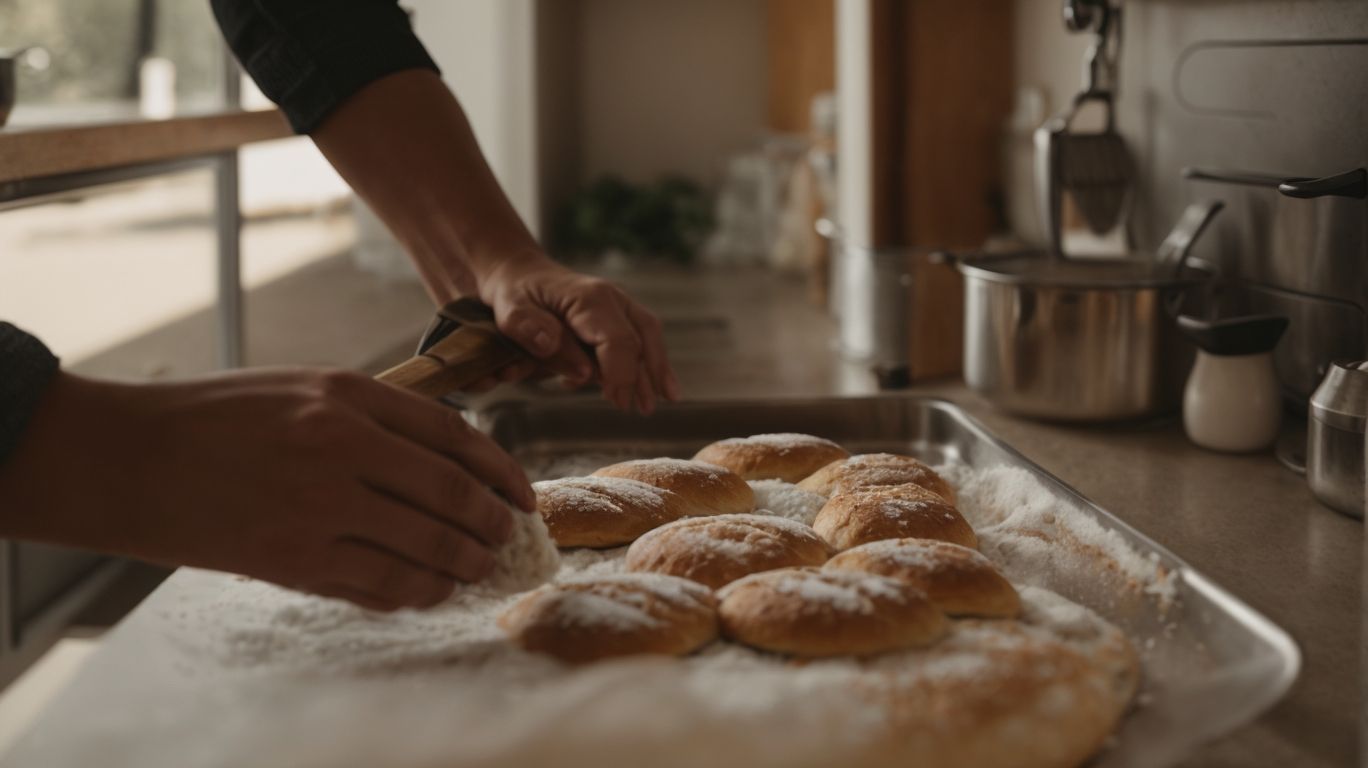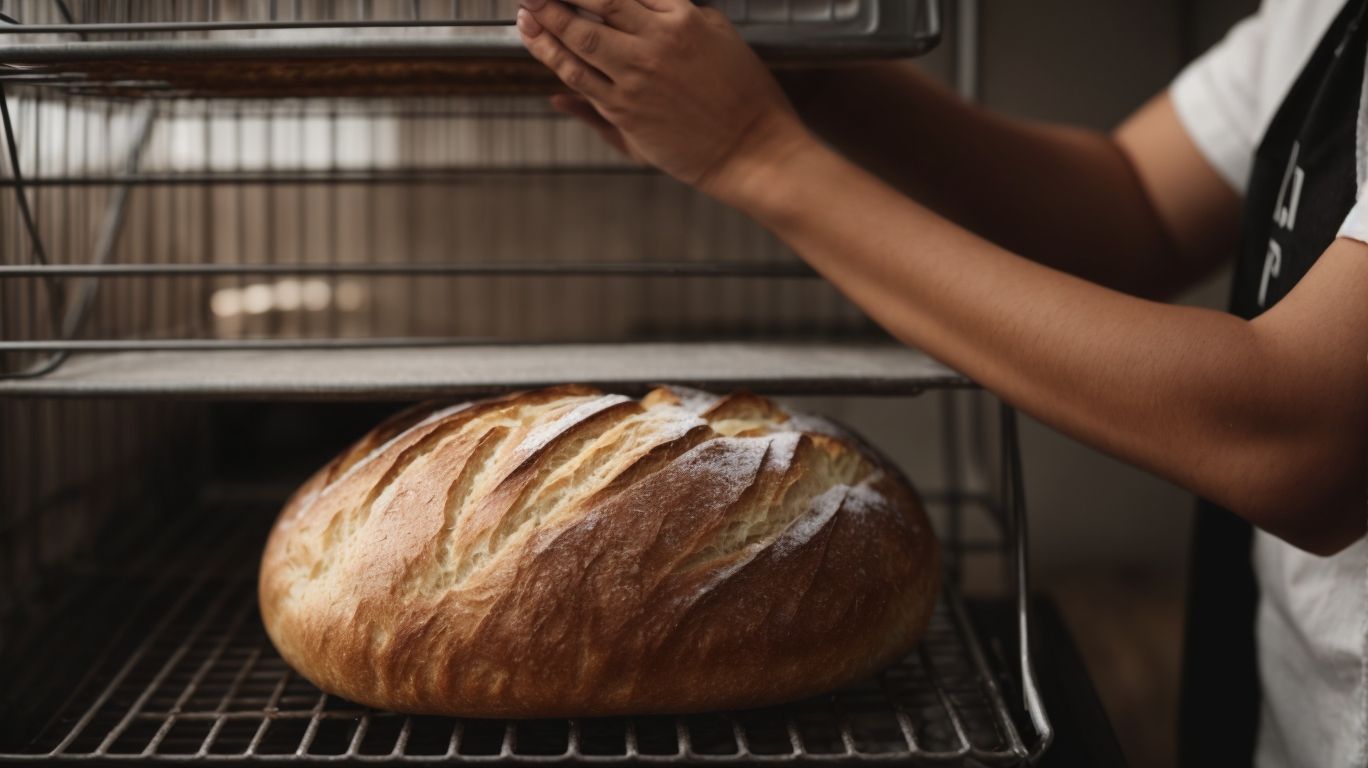How to Bake Sourdough Without a Dutch Oven?
If you’re a fan of baking sourdough bread but don’t have a Dutch oven on hand, fear not!
In this article, we’ll explore the benefits of using a Dutch oven for baking sourdough and provide you with alternative methods to achieve that perfect crust and crumb without one.
From using a cast iron skillet to creating steam in your oven, we’ve got you covered.
So, grab your baking essentials and let’s get started on baking the perfect sourdough loaf.
Key Takeaways:
What Is a Dutch Oven and Why Is It Used for Baking Sourdough?
A Dutch oven is a versatile cooking vessel that has gained popularity for baking sourdough due to its ability to create the perfect baking environment.
One of the key features of a Dutch oven is its thick walls and tight-fitting lid, which help in retaining heat and moisture during the baking process. This ensures that the sourdough bread bakes evenly and rises to perfection, giving it that coveted crispy crust and soft, airy interior.
The Dutch oven’s heat retention capabilities also make it ideal for creating the steamy environment necessary for achieving a professional-level artisanal loaf. This steam helps in developing a beautiful crust, sealing in the bread’s moisture, and producing a satisfying crunch with each bite.
What Are the Benefits of Using a Dutch Oven for Baking Sourdough?
Using a Dutch oven for baking sourdough offers advantages like excellent heat retention, steam generation, and crust development, resulting in artisanal loaves with perfect texture and flavor.
The heat retention of a Dutch oven ensures even distribution of heat throughout the baking process, allowing the sourdough to rise properly and develop a beautiful crust. The steam generated inside the closed environment mimics a professional bread oven, contributing to a moist interior and crispy exterior of the loaf. This unique combination results in bread with a complex flavor profile that is hard to achieve with other baking methods. Baking sourdough in a Dutch oven truly elevates the quality of your homemade bread.
How to Bake Sourdough Without a Dutch Oven?
If you don’t have a Dutch oven, there are alternative methods to bake sourdough bread that can still yield delicious results.
One effective method is to use a cast iron skillet to create a similar baking environment for your sourdough loaf. Simply preheat the skillet in the oven and then carefully transfer your proofed dough into the hot skillet. This mimics the steamy atmosphere that a Dutch oven provides, helping your bread develop that coveted crispy crust.
Another approach is to utilize a baking stone, which can help distribute heat evenly and promote a well-risen loaf. Preheat the stone in the oven and then slide your dough onto the hot surface for baking. This method is great for achieving a golden, crunchy crust on your sourdough.
Alternatively, you can explore using alternative vessels like pyrex dishes or ceramic pots with lids. These can trap moisture while baking, aiding in the crust development. Experiment with different vessels to find the one that best suits your baking preferences and equipment.
Use a Cast Iron Skillet
Baking sourdough in a cast iron skillet can mimic the effects of a Dutch oven, creating a similar steamy environment for a crispy crust and soft crumb.
Preheat your oven to the desired temperature, usually around 450°F, with the cast iron skillet inside to heat it up. Once the oven reaches the temperature, carefully remove the skillet, but be cautious as it’ll be extremely hot. Gently transfer your proofed sourdough dough into the preheated skillet.
To create steam for that perfect crust, you can place a small heatproof dish filled with boiling water in the oven next to the skillet or use a spray bottle to mist water into the oven.
Use a Baking Stone or Pizza Stone
A baking stone or pizza stone can be an effective tool for baking sourdough bread, offering even heat distribution and a crispy crust.
The use of a baking stone or pizza stone goes beyond just improving the crust texture of your sourdough bread. These stones are known for their ability to retain moisture during the baking process, resulting in a loaf that is perfectly moist on the inside while achieving a beautifully golden and crispy outer crust. Apart from enhancing the overall quality of your bread, baking on a stone also helps in achieving a more even bake, ensuring that your sourdough is cooked through evenly without any hot spots.
Use a Dutch Oven Alternative
Exploring Dutch oven alternatives like covered pots, casserole dishes, or even a roasting pan can provide similar results in baking sourdough bread.
When opting for covered pots as a substitute for a Dutch oven, it’s crucial to choose heavy-bottomed ones with tight-fitting lids to retain steam and create that desirable crust on your sourdough.
Casserole dishes are excellent options due to their heat retention properties, but remember to preheat them to mimic the Dutch oven environment perfectly. On the other hand, a roasting pan can work well too; just place a second pan filled with water in the oven while baking to maintain the required level of humidity for a beautifully risen sourdough loaf.
Tips for Baking Sourdough Without a Dutch Oven

Credits: Poormet.Com – Ronald Green
When baking sourdough without a Dutch oven, it’s essential to follow certain tips and techniques to ensure a successful outcome.
Firstly,
- Preheating an alternative vessel, such as a cast-iron skillet or a baking stone, is crucial to create a similar baking environment as a Dutch oven. Place the vessel in the oven during the preheating process to ensure it reaches the desired temperature.
- To mimic the steam effect of a Dutch oven, you can use a water pan or spray the dough with water before placing it in the oven. This step helps achieve the desirable crust and texture of your sourdough.
- Remember to adjust the baking parameters such as temperature and time based on the vessel you are using to ensure your sourdough bakes perfectly.
Preheat Your Alternative Baking Vessel
To ensure proper oven spring and crust development, preheat your alternative baking vessel thoroughly before adding the sourdough dough.
Preheating your alternative baking vessel is crucial for creating the perfect environment for your sourdough bread to rise and bake to perfection. When the vessel is adequately preheated, it jumpstarts the yeast activity in the dough, leading to better fermentation and a more robust rise during baking. This initial burst of heat also aids in the formation of a crispy, golden crust as the moisture from the dough quickly evaporates.
Create Steam in Your Oven
Generating steam in your oven while baking sourdough can help create a moist environment that promotes crust development and oven spring.
One common method to introduce steam into your oven is by placing a pan of water in the bottom during the preheating stage; this water evaporates as the oven heats up, creating steam. Another effective technique is to spray the oven walls with water using a spray bottle right after loading the bread. This instant burst of steam enhances crust formation by delaying the setting of the crust early in the baking process. Both of these methods contribute to a thicker and crunchier crust, deeper color, and an overall improved texture in your sourdough bread.
Adjust Baking Time and Temperature
Fine-tuning your baking time and oven temperature based on the characteristics of your alternative vessel can help achieve the desired texture and flavor in your sourdough bread.
When baking sourdough in vessels like cast iron pans or ceramic pots, it’s essential to allow for proper heat distribution by preheating the vessel. This ensures an even bake and a beautiful crust formation. Keep in mind that different materials may conduct heat differently, affecting how your loaf bakes.
Adjusting the oven temperature slightly up or down can significantly impact the final result. Lower temperatures may require longer baking times to achieve the same level of doneness, while higher temperatures can lead to a darker crust quicker. Observing these nuances and making subtle modifications improves your baking precision.
Common Mistakes to Avoid When Baking Sourdough Without a Dutch Oven

Credits: Poormet.Com – Anthony Jones
Avoiding common mistakes when baking sourdough without a Dutch oven can ensure that your bread turns out perfectly every time.
One crucial error to dodge is selecting an unsuitable vessel for your sourdough. Using a vessel that doesn’t retain heat well or is too small can lead to uneven baking and a lackluster crust.
Another pitfall is inadequate preheating. Proper preheating is essential to ensure that your bread gets the right initial burst of heat for that perfect rise and crust formation.
Failing to generate enough steam during the baking process can result in a dry and dense loaf. Consider using methods like spraying water in the oven or placing a pan of water to create steam.
Using an Inappropriate Alternative Baking Vessel
Selecting the right alternative vessel for baking sourdough is crucial to ensure proper heat distribution and crust formation, avoiding pitfalls associated with unsuitable containers.
Besides preventing uneven baking due to improper heat dispersion, choosing the appropriate vessel can greatly impact the texture of your sourdough bread. The vessel’s material and shape directly influence how the dough rises and interacts with heat, resulting in variations in the bread’s internal crumb structure.
With the right vessel, you can achieve a desirable open crumb and a crust that strikes the perfect balance between crispness and chewiness, enhancing the overall sensory experience of the bread.
Not Preheating Your Oven or Baking Vessel
Failing to preheat your oven or alternative baking vessel adequately can lead to uneven baking, poor crust development, and subpar results in your sourdough bread.
Proper preheating is crucial in sourdough baking as it ensures that your dough receives consistent heat right from the start, aiding in sufficient expansion during baking. When you preheat the oven or your baking vessel, you set the stage for a well-risen loaf with an enticingly golden crust. The heat encourages the fermentation process in the dough, leading to the desirable sourdough flavor. Preheating helps in creating that perfect crispy crust that every sourdough enthusiast craves.
Not Creating Enough Steam
Inadequate steam generation during the baking process can result in a dry crust, limited oven spring, and lackluster texture in your sourdough loaves.
Proper steam generation is crucial in achieving the perfect sourdough bread. When steam is not generated sufficiently, the crust tends to dry out too quickly, hindering proper expansion of the dough during baking. Steam plays a vital role in maintaining the right level of moisture in the crust, ensuring that it retains that desirable chewy texture and crispness. Steam aids in the development of a well-defined crust, giving the loaf its characteristic appearance and enhancing the overall bread structure.
Conclusion: You Can Bake Sourdough Without a Dutch Oven
Baking sourdough without a Dutch oven is not only possible but can also lead to delicious loaves with the right techniques and alternative baking vessels.
One popular alternative for baking sourdough without a Dutch oven is utilizing a cast-iron skillet or a heavy baking sheet. Preheat the skillet in the oven for at least 30 minutes before transferring your proofed dough onto it for baking. Steam plays a crucial role in achieving that coveted crust, mimicking the Dutch oven effect. A small pan filled with water placed on a lower rack during the initial baking period can provide the necessary moisture. Consistent oven temperature and proper dough development are key to a successful sourdough loaf without a Dutch oven.
Frequently Asked Questions
1. Can I bake sourdough without a Dutch oven?
Yes, you can! While a Dutch oven is commonly used for baking sourdough, there are other options available that can yield similar results.
2. What can I use instead of a Dutch oven for baking sourdough?
You can use a cast iron skillet, a baking stone, or even a large oven-safe pot with a lid as alternative options for baking sourdough without a Dutch oven.
3. How can I create steam without a Dutch oven for baking sourdough?
To create steam, you can place a tray of ice cubes in the bottom of your oven while preheating. Once you place your sourdough in the oven, the ice will melt and create steam, giving your bread a crispy crust.
4. How do I adjust baking times when using alternative methods for baking sourdough?
When using a cast iron skillet or baking stone, you may need to adjust the baking time as they heat up differently than a Dutch oven. Keep an eye on your bread and use a thermometer to ensure it is fully baked.
5. Can I use a glass baking dish instead of a Dutch oven for baking sourdough?
While you can use a glass baking dish, it is not recommended as it can shatter under the high heat required for baking sourdough. Stick to using oven-safe materials such as cast iron or ceramic.
6. Are there any benefits to using a Dutch oven for baking sourdough?
Using a Dutch oven can help create the perfect environment for baking sourdough, as it traps steam and allows for even heat distribution. However, it is not necessary and you can still achieve great results without one.

